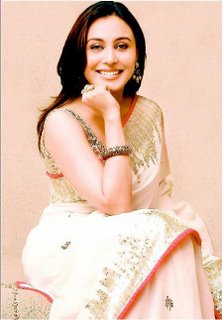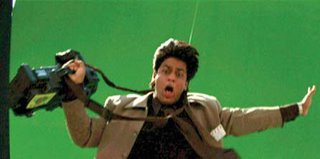Queen of Bollywood
 She defies all logic of being the number one actress of Bollywood. With 5’ 2” height, ordinary vital stats, a simple face and an unusual, irritating (yes to many) voice, she might not come across as a typical Bollywood queen to an onlooker. Unlike most of the previous number one actresses in Hindi Cinema (the exceptionally beautiful Madhubala, dreamgirl Hema Malini, seductive Rekha, sensuous Sridevi, magnificent Madhuri Dixit or the lethal beauty Aishwarya), she has no extraordinary charms.
She defies all logic of being the number one actress of Bollywood. With 5’ 2” height, ordinary vital stats, a simple face and an unusual, irritating (yes to many) voice, she might not come across as a typical Bollywood queen to an onlooker. Unlike most of the previous number one actresses in Hindi Cinema (the exceptionally beautiful Madhubala, dreamgirl Hema Malini, seductive Rekha, sensuous Sridevi, magnificent Madhuri Dixit or the lethal beauty Aishwarya), she has no extraordinary charms.One really wonders, how this ‘petite actress’ has managed to thrive, or rather establish an unchallenged reign (so far) in the film industry (which has seen sexy sirens the likes of Mumtaz, Zeenat Aman & Parveen Babi in the past, not to forget the present generation’s in–your-face exposure queens like Mallika Sherawat or Tanisha).
The answer is, her ordinary self is the very essence of her extraordinary talent. Not convinced? Well, take your memory back several decades when a short-statured actress entered Hindi cinema which was then ruled mostly by sensuous beauties. With the superiority of her talent she took the industry by storm. With her simplicity of heart, this ‘Millee’ or ‘Guddi’ left an everlasting imprint in the minds and hearts of the viewers. It seemed that such class would never be found or matched again. Well, how true it was!
The wait was pretty long. But, finally, ‘our girl next door’ arrived to fill the spot. Yes, (with no offence to any one), the sheer brilliance and superiority of Rani Mukherjee’s talent can only be compared with that of ‘one of the finest actresses of Hindi cinema’ Jaya Bhaduri.
Rani, the light-eyed actress was born on March 21, 1978. Being the daughter of director Ram Mukherjee, acting was in her blood. Despite her film background, she struggled like an ordinary starlet. Not many people know that Bollywood wouldn’t have got the chance to see her potential had she got married to a guy she liked before making her acting debut. However, destiny had something else in store for her. Her parents didn’t approve of the guy and after a few days of heartbreak, Rani recollected her senses and made her film debut in the movie ‘Raja Ki Aayegi Baraat’. Thought her performance (as a rape victim) did show some signs of what was to come, the movie bombed at the box office. It was followed by an equally forgetful ‘Mehndi’. Then she disappeared from the scene for a while.
But she bounced back with the Aamir Khan-starrer ‘Ghulam’ and earned country-wide fame as the ‘Khandala Girl’. She was not only noticed but appreciated in the movie as well. It was at this time that she was offered the role of Tina by Karan Johar for his first directorial venture Kuch Kuch Hota Hai. But there was a slight problem here. She was overweight and pitted against the golden couple (SRK and Kajol, who is incidentally her cousin and the top actress then). But she accepted the challenge. And boy, she gave a sizzling performance and even won the Best Supporting Actress Award for the movie.
The best part was that she finally emerged out of the so-called shadow of her cousin. She then worked in Kamal Haasan’s controversial flick ‘Hey Ram’ thinking that it would take her career to new heights. But it didn’t happen. In the next two to three years, the wrong choice of movies cost Rani’s career dearly. Her senseless movies with Govinda and Bobby Deol (Hadh Kar Di Aapne, Badal, Bichchoo etc.), extra flab and horrendous dressing sense, a la Govinda earned her flak from the audience.
Her career had hit rock bottom at this time and rumours of her alleged link-up with Govinda further ruined her career. Nothing seemed to be working for her. One after the other, all her movies (Kahin Pyar Na Ho Jaye, Pyar Diwana Hota Hai, Bus Itna Sa Khwab Hai, Nayak, Chori Chori, Chalo Ishq Ladaye etc) failed.

But Rani was a born fighter. Though she had full confidence in her acting abilities, she felt something was still missing. She then followed a rigorous diet regime, worked on her looks, took on the services of Manish Malhotra and vowed not to sign movies rashly. Now, she needed the right opportunity. And it did come. From the very banner that every actress dreams of being a part of. She signed newcomer Shaad Ali’s movie ‘Saathiya’ under the Yash Raj banner. It proved to be the turning point of her career. The audience saw a completely transformed Rani, sexy yet with the innocence of the girl-next-door. Her wonderful performance won her the Filmfare Critic Award for Best Actress.
Apart from the wide acclaim, she got what every actress desired for. The faith of the Chopras. They repeated her in Kareena-Hritik starrer Mujhse Dosti Karoge.
Rani’s pleasing nature, humility, genuine smile and sincerity of emotions have won her numerous friends in the industry. No wonder she is the hot favourite of most of the so-called camps, the romance kings Chopras, Khans (Aamir and Shahrukh are among her best friends), Johars, Bachchans and even the talent powerhouse Bhansali. How many actresses can boast of having direct access to the shoulder of Aamir Khan to cry on when Karan Johar preferred Preity Zinta over Rani for Kal Ho Na Ho.
Rani’s dignified nature has never allowed her ‘to bitch’ about other actresses or actors for the gossip magazines. She just knows how to win friends and keep them with her forever.
She values friendship and worships work. Unlike several other top actresses (a la Kareena) who give prominence to their price tag, Rani’s is always willing to lower her price for a good role.
Rani made some fantastic career moves in 2004 and 2005. She accepted the offer of SRK productions’ Chalte Chalte (earlier offered to Ash) and it turned out to be one of the biggest hits of 2004 though it soured her relations with the former Miss World. She delivered a great performance in Calcutta Mail (a lesser known film). She also won wide acclaim for Chopra`s Veer Zaara. By this time she had refined her acting skills to such a level that she created a records of sorts by winning the Filmfare Awards for Best Actress and Best Supporting Actress in 2004 for Hum Tum and Yuva.
None of her contemporaries (Ash, Preity or Kareena) could match her in terms of box-office success, critical acclaim and big banners. Even her friend and professional rival Kareena, when once asked what Rani had that she didn’t, was quick to reply ‘the Chopras’. Rani’s midas touch continued in 2005 with big successes like Bunty Aur Babli and Paheli. However, with Bhansali’s Black she has entered the genre of Shabana Azmi and Smita Patil. Rani went on to win the prestigious Filmfare Best Actress Award for her portrayal of a dumb, deaf and blind girl in Black. She also won Zee Cine Award for the same category. No wonder, Bhansali, one of the most talented directors today, has termed Rani the best actress in the country of this generation.
The vibrance, sincerity and emotional appeal of the light-eyed Bengali beauty, combined with her unmatched talent, are an inspiration for the rest to follow.

